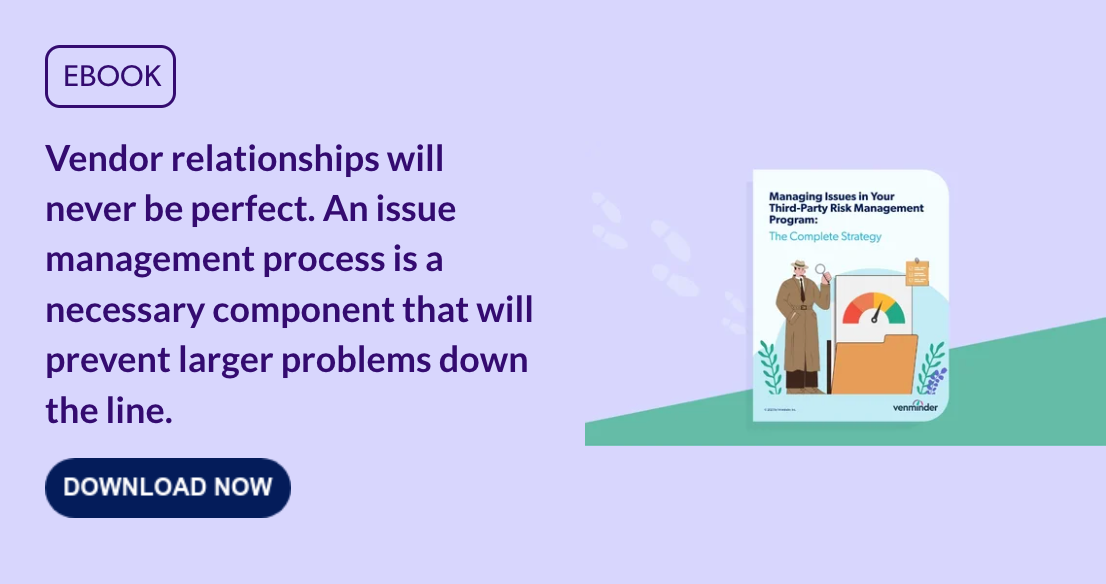Relationships are imperfect, and sooner or later, issues will need to be resolved. Maybe you have plenty of experience resolving issues successfully within friendship, marriage, and family, but what about issues in your vendor relationships?
A vendor issue is any unexpected result or scenario that needs further evaluation or action to mitigate risk. Fortunately, there’s an effective strategy known as issue management that can be implemented into your vendor risk management program.
Issue management is the process of identifying, addressing, and resolving unexpected situations that occur within your vendor relationships. Ultimately, issue management can be an important tool in determining whether it’s best to continue the relationship or break up with your vendor.
The Importance of Vendor Issue Management
Vendor relationships can be highly valuable yet unpredictable, so it’s important to be proactive and consider how your organization will manage any issues. In general, it’s a good idea to adopt the motto of “hope for the best and prepare for the worst” when it comes to vendor issues.
Here’s why vendor issue management is so important:
- It’s a regulatory expectation. Regulators in industries like the financial services expect organizations to manage vendor risk, which includes a process for managing and escalating issues. Even if your organization isn’t under these regulations, it’s still a best practice for vendor risk management.
- It prevents reputational harm from vendor actions. Vendor issues that aren’t properly managed can escalate to larger problems and reflect poorly on your organization.
- It supports risk mitigation. Certain vendor issues can also elevate other risk areas like cybersecurity and operational risk, especially when they involve critical or high-risk vendors. Issue management helps mitigate these risks and protects your organization and customers.
- It remediates contractual discrepancies. Issue management provides documented evidence when a vendor fails to meet contractual obligations such as service level agreements (SLAs). This evidence can then be used to renegotiate the contract for better terms or initiate early termination.
- It protects your financial health. Resolving vendor issues in a consistent, timely manner can help avoid a negative financial impact that comes from unplanned expenses, regulatory fines, litigation, or lost revenue from dissatisfied customers.
3 Examples of Vendor Issues
Issues can occur at any stage throughout the vendor risk management lifecycle. Some issues left unmanaged could potentially lead to larger problems in other stages, so it’s important to always stay vigilant for situations that could impact a vendor’s risk.
Here are three examples by category of vendor risk management issues:
- Due diligence – Your vendor hasn’t yet resolved failures found during their previous disaster recovery test. This could be a significant concern and risk if the vendor is critical to your operations. The situation may indicate your vendor is unable to resume operations after an unexpected event, which would then lead to an interruption at your organization.
- Performance monitoring – Ongoing monitoring has revealed a pattern of declining performance in your vendor’s service, such as slower delivery time or increased downtime. This type of vendor issue might occur gradually, but still should be addressed. It could lead to larger problems, like dissatisfied customers and damage to your organization’s reputation. It could also impact your own operations that rely on the vendor’s product or service.
- Termination – After terminating the vendor contract, your organization still hasn’t received a Certificate of Destruction, which verifies that your data has been properly destroyed. This issue could put you at risk of a data breach, so it’s essential to document and monitor the situation until it’s resolved.

How to Create a Vendor Issue Management Process
Any vendor issue, like the examples above, will of course contain a variety of variables. Two different vendors that experience the same issue may require two very different responses and actions to resolve. Much of this depends on inherent risk factors associated with the vendors’ products and services.
To address this, it’s important to develop a thorough process so vendor issues can be managed effectively – regardless of what the vendor issue is. Here’s a general outline of the vendor issue management process:
- Formalize the process – Consider how your organization will define an issue and develop a method to rate or classify issues based on severity. Standardize issue management logs and reporting and identify individuals who can escalate, report, and manage vendor issues. You should record the issue management process in your vendor risk management policy and program documentation.
- Identify the issues – After you’ve formalized the process, you can begin identifying vendor issues. You’ll need to determine what types of vendor issues should be included, which could include a security incident, poor communication, unmet SLAs, or failing to provide due diligence.
- Determine issue severity – This prioritizes the most significant issues and ensures your resources are properly allocated where they’re needed most. Your organization will need to determine the type of ranking or classification to use, but some examples might include a scale of severe, high, moderate, low, and watch. The severity helps stakeholders understand what the next steps are.
For example, a severe issue, such as a data breach, might need to be immediately escalated to the board and senior management. An issue regarding late due diligence might only rank as low severity, which may just warrant more frequent monitoring.
- Manage the issues – This will generally be a collaborative activity between the person overseeing all the vendor issues and specific teams and departments working with the vendor daily. Managing vendor issues involves documenting and tracking different data points such as the vendor’s name, the product or service, the vendor owner, the root cause of the issue, and the escalation process. Vendor issues can occur all throughout the lifecycle so it’s important to maintain a consistent process for tracking data.
- Track and resolve the issues – Vendor risk management often has many competing priorities, but it’s important to consistently track your vendor issues through remediation. You may want to conduct regular discussions with the vendor owner and vendor throughout this step, and keep your team informed on the progress. Consider an action plan and the expected outcome and deadline for remediation. You should also identify who’s responsible for reviewing and approving the remediation. The severity of the issue should also determine whether you need to test an exit plan before the issue is formally resolved.
Sometimes, vendor issues can be the ultimate test of the relationship. A vendor that communicates openly and strives to resolve issues quickly can indicate a healthy relationship that’s built to last. A vendor that disregards issues with ambivalence and poor communication is probably a good sign that the relationship is on shaky ground and should end soon before things get worse.





.gif?width=1920&name=Sample-Graphic-Animation%20(1).gif)




